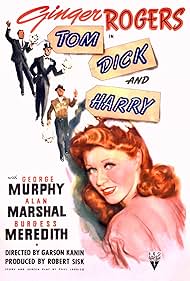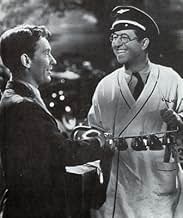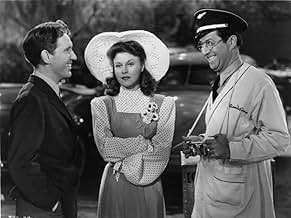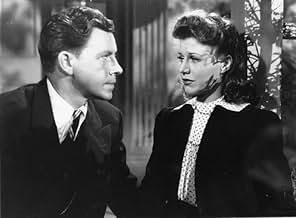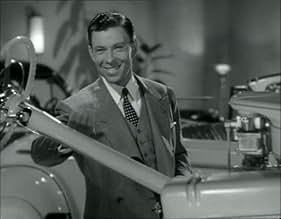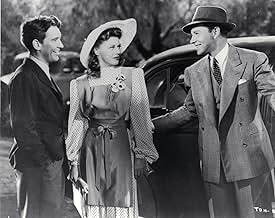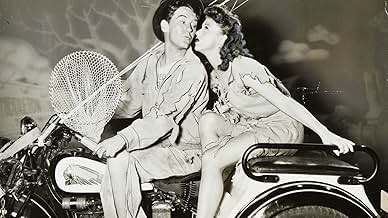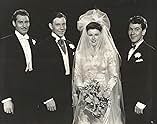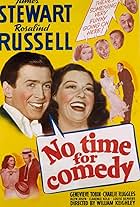IMDb RATING
6.3/10
1.3K
YOUR RATING
Working girl Janie is proposed to by a conservative car salesman, a bohemian auto mechanic, and a millionaire playboy and must make a choice.Working girl Janie is proposed to by a conservative car salesman, a bohemian auto mechanic, and a millionaire playboy and must make a choice.Working girl Janie is proposed to by a conservative car salesman, a bohemian auto mechanic, and a millionaire playboy and must make a choice.
- Nominated for 1 Oscar
- 4 wins & 1 nomination total
Vickie Lester
- Paula
- (as Vicki Lester)
Edward Colebrook
- Stalled Car Driver
- (scenes deleted)
Dorothy Lloyd
- Gypsy Oracle
- (scenes deleted)
Gertrude Short
- Bridge Matron
- (scenes deleted)
William Alland
- Newsreel Announcer
- (voice)
- (uncredited)
Michael Audley
- Usher
- (uncredited)
Joseph E. Bernard
- Judge in Dream
- (uncredited)
Maurice Brierre
- French Waiter
- (uncredited)
Jack Briggs
- Boy in Dream
- (uncredited)
Featured reviews
In fact everyone is at the top of their form in this wonderfully entertaining movie, but Ginger has never been better. Even Alan Marshall, who frequently came across in films as being a little on the smarmy side, is quite likeable here. And Phil Silvers is wonderfully obnoxious as the ice-cream salesman.
It is interesting to compare this film with it's 1957 remake "The Girl Most Likely", which apart from its musical numbers sticks pretty close to the original. Now "The Girl Most Likely" is quite an entertaining film in itself, and Jane Powell is certainly a talent not to be sneezed at. But having seen both films a number of times it always surprises me just how much better "Tom, Dick and Harry" is, and how flat "The Girl Most Likely" seems in comparison. Garson Kanin has somehow managed to infuse a lightness and subtlety of wit into the original which seems to have eluded Mitchell Leisen in the remake. And of course the three male leads in "The Girl Most Likely" don't hold a candle to the three male leads here.
It is interesting to compare this film with it's 1957 remake "The Girl Most Likely", which apart from its musical numbers sticks pretty close to the original. Now "The Girl Most Likely" is quite an entertaining film in itself, and Jane Powell is certainly a talent not to be sneezed at. But having seen both films a number of times it always surprises me just how much better "Tom, Dick and Harry" is, and how flat "The Girl Most Likely" seems in comparison. Garson Kanin has somehow managed to infuse a lightness and subtlety of wit into the original which seems to have eluded Mitchell Leisen in the remake. And of course the three male leads in "The Girl Most Likely" don't hold a candle to the three male leads here.
10timmauk
This is one of Ginger Rogers best films of all time. Here we see her trying to find the man of her dreams. She thinks she knows what she wants but does she really?? One by one she runs into these three men who are each special to her in their own way, but she must decide on which one of them she wants to live her life with. The dream sequences are very funny and add to the sheer joy of the film. You'll love the ending!
This film gives us three killer performances, Rogers of course, George Murphy and Burgess Meredith. The others actors are good as well. This is a funny heart warming movie that doesn't disappoint. If you have a chance to see or get this movie, DO IT!!
This film gives us three killer performances, Rogers of course, George Murphy and Burgess Meredith. The others actors are good as well. This is a funny heart warming movie that doesn't disappoint. If you have a chance to see or get this movie, DO IT!!
The expression "Tom, Dick and Harry" is a commonly-used colloquialism in English, meaning "everybody" or "anybody", but this film is about three men who just happen to have those names. The main character is Janie, a young woman who works in a telephone exchange and who has the sort of obliging personality which means she just can't say "no" to anybody, especially a good-looking young man. So it happens that she ends up engaged to three men from three different social backgrounds at the same time, middle-class car salesman Tom, working-class garage mechanic Harry and upper-class Dick, the son of the local millionaire. All three are young and good-looking, but all have their drawbacks; Tom is a bit too staid and conservative, Harry a bit too eccentric and Dick a bit too smooth and slick.
There's not really a lot more to the plot than that, apart from waiting to see which of the three men Janie will eventually end up marrying. In real life, of course, no woman would ever behave like this unless she were either a heartless flirt or not quite right in the head, but this is a screwball comedy, a film genre which acknowledges the existence of real life but does not consider itself bound by the rules and conventions that prevail there. It is, however, a tribute to Ginger Rogers' comedic talents that she manages to make her character seem not only plausible but also reasonably sympathetic.
Even in 1941 this film was probably not seen as anything more than a light-hearted bit of trivia, although it does manage a serious bit of political comment when a cinema audience are shown booing a newsreel showing Hitler. (The film was made before Pearl Harbor, but Hollywood had declared war on the Third Reich long before Washington followed suit). It is made in the "filmed theatre" style popular for low-budget films of the period- more dialogue than action, most scenes taking place indoors and everything seemingly filmed on one camera with no cross- cutting or tricky camera work. Today it is largely forgotten, but Ginger manages to invest it with enough period charm to make it (just about) worth watching. 6/10
There's not really a lot more to the plot than that, apart from waiting to see which of the three men Janie will eventually end up marrying. In real life, of course, no woman would ever behave like this unless she were either a heartless flirt or not quite right in the head, but this is a screwball comedy, a film genre which acknowledges the existence of real life but does not consider itself bound by the rules and conventions that prevail there. It is, however, a tribute to Ginger Rogers' comedic talents that she manages to make her character seem not only plausible but also reasonably sympathetic.
Even in 1941 this film was probably not seen as anything more than a light-hearted bit of trivia, although it does manage a serious bit of political comment when a cinema audience are shown booing a newsreel showing Hitler. (The film was made before Pearl Harbor, but Hollywood had declared war on the Third Reich long before Washington followed suit). It is made in the "filmed theatre" style popular for low-budget films of the period- more dialogue than action, most scenes taking place indoors and everything seemingly filmed on one camera with no cross- cutting or tricky camera work. Today it is largely forgotten, but Ginger manages to invest it with enough period charm to make it (just about) worth watching. 6/10
"Tom Dick and Harry", a delightful screwball comedy, features Ginger Rogers sans singing and tapping. Rogers is cast as a telephone operator living with family and the eldest of two daughters. At first she seems a bit mature for the role but turns in a good performance as the comedy and surrealistic sequences become increasingly engaging along with the social-commentary subtext of traveling in various social circles to supplement the plot: Rogers on a whirlwind-whim steps out of an unfulfilling job and pursues an ultimate soulmate/marriage/happiness. Some scenes surprisingly echo "The Philadelphia Story" (1940) in an inverted economic pearls-at-a-price manner: after an evening of mayhem lasts into wee-morning hours and before the "life-altering" event, an ultimate awakening dawns upon working-class Rogers similar to high-society Hepburn. Also, similar to TPS, TD&H has the wisecracking-realistic younger sister balancing the impulsive older sister Rogers; the supporting cast delivering the sideshow goods; and viewers getting the surprise-ending treat. Trivial tidbit: Lenore Lonergan, (the younger sister "Butch" to Rogers's "Janie" in TD&H), is cast in the original Broadway version of TPS as the younger sister "Dinah" to Hepburn's "Tracy", (however in the film version of TPS, Virginia Weidler plays the younger sister "Dinah" part).
There are so many great films in the comedy, romance and fantasy genres individually and there are some great ones that combine all three. It is interesting when any film combines all three, and luckily the three do gel well together and when done well the effect is not tonally muddled or disjointed. Another interest point was seeing Ginger Rogers, most famous for her legendary dance partnership with Fred Astaire, in one of her non-dancing roles.
While falling short of being a great film, 'Tom, Dick and Harry' did entertain and charm me as an overall whole. Much more so than the simplistic title indicates. Not everything comes off well, with one problem being major enough sadly to stop me from getting fully invested in the film. The reason for the above average rating though is because there are a lot of good things in 'Tom, Dick and Harry', and those good things manage to be so good.
Am going to begin with what doesn't quite work. One doesn't really see this type of film for their stories, where one expects them to be lacking in surprises, very flimsy and with contrivances and silliness overkill. 'Tom, Dick and Harry' is no exception, with pretty much all of those things. Plus an ending that wraps things up too neatly.
More problematic though is that one never fully warms to the lead character, and we are talking about the character and not Rogers, a very unsubtle one and difficult to empathise with, at times we are even irritated. Consequently, it is neither fully easy to invest in the relationships or what her final decision and reasoning are.
However, there is a lot to enjoy still. Despite having problems with the character, Rogers herself is actually marvellous, throwing herself into the role with sparkling comic timing and forthright commitment while injecting some charm. The male characters could have done with more development perhaps, but the titular characters are all well played. Especially Burgess Meredith as Harry. A pleasant surprise too was how Phil Silvers managed to make an obnoxious character amusing and surprisingly endearing, two words that usually don't belong in the same sentence as that. The direction has energy and the right lightness of touch and doesn't feel heavy or static.
It looks very nice as a film, especially Rogers' clothes (which she looks stunning in) and the imaginative photography in the enchanting and wonderfully weird dream sequences. The music fits well tonally and doesn't intrude. Throughout the dialogue sparkles in its wit and there are more than a fair share of funny, if not quite hilarious, moments that come rolling fast. The story is very flawed, but at least it didn't feel dull or strained to me and had a nice light on the feet energy.
On the whole, not great but pretty entertaining in its own way. 6/10
While falling short of being a great film, 'Tom, Dick and Harry' did entertain and charm me as an overall whole. Much more so than the simplistic title indicates. Not everything comes off well, with one problem being major enough sadly to stop me from getting fully invested in the film. The reason for the above average rating though is because there are a lot of good things in 'Tom, Dick and Harry', and those good things manage to be so good.
Am going to begin with what doesn't quite work. One doesn't really see this type of film for their stories, where one expects them to be lacking in surprises, very flimsy and with contrivances and silliness overkill. 'Tom, Dick and Harry' is no exception, with pretty much all of those things. Plus an ending that wraps things up too neatly.
More problematic though is that one never fully warms to the lead character, and we are talking about the character and not Rogers, a very unsubtle one and difficult to empathise with, at times we are even irritated. Consequently, it is neither fully easy to invest in the relationships or what her final decision and reasoning are.
However, there is a lot to enjoy still. Despite having problems with the character, Rogers herself is actually marvellous, throwing herself into the role with sparkling comic timing and forthright commitment while injecting some charm. The male characters could have done with more development perhaps, but the titular characters are all well played. Especially Burgess Meredith as Harry. A pleasant surprise too was how Phil Silvers managed to make an obnoxious character amusing and surprisingly endearing, two words that usually don't belong in the same sentence as that. The direction has energy and the right lightness of touch and doesn't feel heavy or static.
It looks very nice as a film, especially Rogers' clothes (which she looks stunning in) and the imaginative photography in the enchanting and wonderfully weird dream sequences. The music fits well tonally and doesn't intrude. Throughout the dialogue sparkles in its wit and there are more than a fair share of funny, if not quite hilarious, moments that come rolling fast. The story is very flawed, but at least it didn't feel dull or strained to me and had a nice light on the feet energy.
On the whole, not great but pretty entertaining in its own way. 6/10
Storyline
Did you know
- TriviaDuring the shooting of this film, Ginger Rogers won the Academy Award® for Best Actress for her previous film, Kitty Foyle (1940). The day after, all of the male cast and crew met her on the set in top hats and tails.
- GoofsThe titles schedule Phil Silvers as "Ice Cream Man" rather than as a character with a name, but, on one occasion, one of them greet him as "Phil" which is, of course, his real name outside the movie.
- Quotes
Phil - Ice Cream Vendor: You don't have to yell at me because I'm a little obnoxious
- Crazy creditsIn the opening titles, it shows some of the names spelled incorrectly, then the letters tumble to the bottom of the screen, scramble themselves and return to their original position, with the correct spellings. This is how they appear: SNIRGOR GREEG = GINGER ROGERS GREGORE YUMPH = GEORGE MURPHY HASALMAR NALL = ALAN MARSHAL ESSRUDE MITHGREB = BURGESS MEREDITH SERT BORISK = ROBERT SISK RILA COJURPA = PAUL JARRICO OSKAR INGNAN = GARSON KANIN
- ConnectionsFeatured in Hollywood the Golden Years: The RKO Story: A Woman's Lot (1987)
Details
Box office
- Budget
- $806,000 (estimated)
- Runtime1 hour 27 minutes
- Color
- Aspect ratio
- 1.37 : 1
Contribute to this page
Suggest an edit or add missing content

